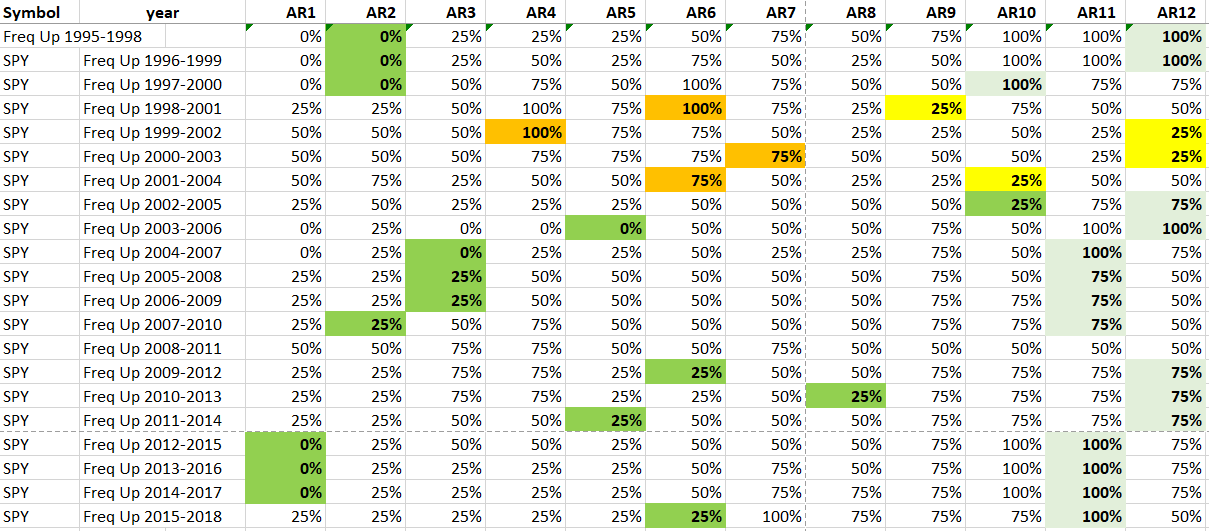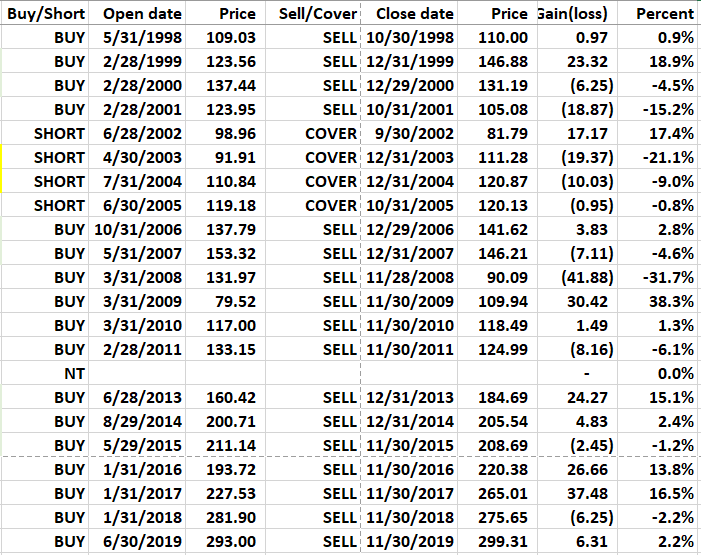In “A Simple Way To Trade Seasonality” in the September 2019 Stocks & Commodities, author Perry Kaufman describes methods he uses for measuring the seasonality in markets and approaches he uses for trading these patterns
Editors note: The full article can be obtained from Stocks & Commodities magazine at
http://technical.traders.com/sub/sublog2.asp#Sep the system rules are from the article and are based on these rules
1. Average the monthly frequency of the past 4 years.
2. Find the last occurrence of the highest frequency and the last occurrence of the lowest frequency using the average frequency in step 1. That is, if both March and April have a frequency of 70, we use April.
3. Only trade if the high frequency is 75% or greater and the low frequency is 25% or lower.
4. If the high frequency comes first, sell short at the end of the month with the high frequency. Cover the short at the end of the month with the low frequency.
5. If the low frequency comes first, buy at the end of the month with the low frequency. Sell to exit at the end of the month with the high frequency
The importable AIQ EDS file and Excel spreadsheet for Perry Kaufman’s article can be obtained on request via email to info@TradersEdgeSystems.com. The code is also shown below
!A Simple Way to Trade Seasonality !Author: Perry Kaufman, TASC September 2019 !Coded by: Richard Denning, 07/21/2019 !www.TradersEdgeSystem.com C is [close]. year is 2019. len is 4000. OSD is offsettodate(month(),day(),year()). FirstDate is firstdatadate(). EOM1 if Month()=2 and valresult(month(),1)=1 and year()=year. EOMos1 is scanany(EOM1,len) then OSD+1. EOMc1 is valresult(C,^EOMos1). EOM2 if Month()=3 and valresult(month(),1)=2 and year()=year. EOMos2 is scanany(EOM2,len) then OSD+1. EOMc2 is valresult(C,^EOMos2). EOM3 if Month()=4 and valresult(month(),1)=3 and year()=year. EOMos3 is scanany(EOM3,len) then OSD+1. EOMc3 is valresult(C,^EOMos3). EOM4 if Month()=5 and valresult(month(),1)=4 and year()=year. EOMos4 is scanany(EOM4,len) then OSD+1. EOMc4 is valresult(C,^EOMos4). EOM5 if Month()=6 and valresult(month(),1)=5 and year()=year. EOMos5 is scanany(EOM5,len) then OSD+1. EOMc5 is valresult(C,^EOMos5). EOM6 if Month()=7 and valresult(month(),1)=6 and year()=year. EOMos6 is scanany(EOM6,len) then OSD+1. EOMc6 is valresult(C,^EOMos6). EOM7 if Month()=8 and valresult(month(),1)=7 and year()=year. EOMos7 is scanany(EOM7,len) then OSD+1. EOMc7 is valresult(C,^EOMos7). EOM8 if Month()=9 and valresult(month(),1)=8 and year()=year. EOMos8 is scanany(EOM8,len) then OSD+1. EOMc8 is valresult(C,^EOMos8). EOM9 if Month()=10 and valresult(month(),1)=9 and year()=year. EOMos9 is scanany(EOM9,len) then OSD+1. EOMc9 is valresult(C,^EOMos9). EOM10 if Month()=11 and valresult(month(),1)=10 and year()=year. EOMos10 is scanany(EOM10,len) then OSD+1. EOMc10 is valresult(C,^EOMos10). EOM11 if Month()=12 and valresult(month(),1)=11 and year()=year. EOMos11 is scanany(EOM11,len) then OSD+1. EOMc11 is valresult(C,^EOMos11). EOM12 if Month()=1 and valresult(month(),1)=12 and valresult(year(),1)=year. EOMos12 is scanany(EOM12,len) then OSD+1. EOMc12 is valresult(C,^EOMos12). YEARavg is (EOMc1+EOMc2+EOMc3+EOMc4+EOMc5+EOMc6+EOMc7+EOMc8+EOMc9+EOMc10+EOMc11+EOMc12)/12. AR1 is (EOMc1 / YEARavg-1)*100. AR2 is (EOMc2 / YEARavg-1)*100. AR3 is (EOMc3 / YEARavg-1)*100. AR4 is (EOMc4 / YEARavg-1)*100. AR5 is (EOMc5 / YEARavg-1)*100. AR6 is (EOMc6 / YEARavg-1)*100. AR7 is (EOMc7 / YEARavg-1)*100. AR8 is (EOMc8 / YEARavg-1)*100. AR9 is (EOMc9 / YEARavg-1)*100. AR10 is (EOMc10 / YEARavg-1)*100. AR11 is (EOMc11 / YEARavg-1)*100. AR12 is (EOMc12 / YEARavg-1)*100. EOMc if firstdate < makedate(1,20,2019-20). AR if EOMc.
The EDS code is not a trading system but a way to get the data needed into an Excel spreadsheet to enable you to make the seasonal calculations. The EDS file should be run on a date after the end of the year being calculated. Each year for which data is needed must be run separately by setting the “year” variable. Multiple symbols can be run at the same time by using a list of the desired symbols. Each time a year is run, the “AR” report must be saved as a “.csv” file. Once all the years needed have been run and saved to separate “.csv” files, they all should be cut and pasted to a single Excel sheet. They then can be sorted by symbol and each symbol can be copied and pasted to a tab for that symbol.
Figure 6 shows the rolling four-year frequency for the S&P 500 ETF (SPY) and Figure 7 shows the annual trades resulting from applying the seasonal rules to the frequency data.

FIGURE 6: AIQ. Shown here is the rolling four-year frequency for the SPY.

FIGURE 7: AIQ. Shown here are the annual trades resulting from applying the seasonal rules to the frequency data for SPY.
—Richard Denning
info@TradersEdgeSystems.com
for AIQ Systems
